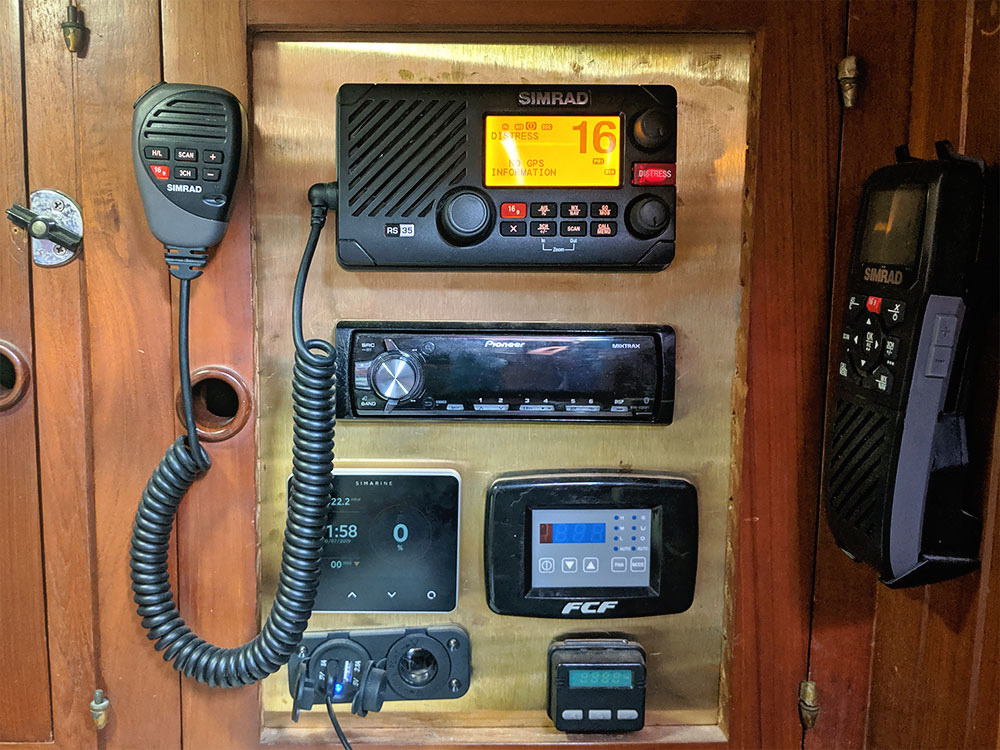Diesel Auxiliary Trouble

I have a ComPac23 Diesel sailboat that I am restoring. I am having trouble getting the 8 HP 1GM10 Yanmar diesel to start. There is plenty of fresh fuel in the tank and I have replaced all the fuel filters and cleaned the injector. The batteries are new and fully charged. The compression test shows 300 PSI. Yet, it just cranks and there is no combustion. I am seeking help. Can you recommend a good Yanmar diesel mechanic I can talk to?
–Capt. Rob, Waleska, Georgia
Hi Rob,
We’re not mechanics, but we’ve lived for years with 3 diesel engines: a Universal 5411 (11hp), a Yanmar 4JH-TE (55hp turbo), and an International 7.3L IDI (in our truck).
Assuming the 300psi compression value is correct for your engine, we can think of only three possible culprits:
- Air in the fuel line
- Poor injection
- Not enough pressure from the high-pressure pump
Here’s what we know about those scenarios:
- On our Yanmar, we had a problem where it died and wouldn’t restart. We removed the primary (on the engine) spin-on fuel filter and it was half-empty. We filled it, it started, then died 10 minutes later. More air had appeared in this filter cartridge. The fuel tank was full. The air was being sucked in from old fuel lines that had cracks or were too stiff to get a good seal at the fittings they attached to. Replaced lines, problem solved. If you’re sucking air someplace, this will cause a no-start problem. In addition to checking the filter, do your regular bleed procedure and see if you can find air anywhere. In addition, while cranking, you can crack the nuts attaching the metal fuel line to the top of your injector–you should see fuel spitting out. If not, it’s likely a pump problem or an air problem.
- You wrote that you “cleaned” the injector. Injectors are not DIY, so your problem could very well be a bad injector. But the only way to diagnose this is to send it in to a diesel injector shop. Our advice is to buy a new injector to install and if that solves your problem, have the old injector serviced and keep it as a spare. As you know, diesel will not combust until atomized, and that must happen at about 3,000 psi and if an injector is “clean” it could still have a weakened spring that’s releasing the fuel in a dribble or something.
- Our understanding is that high-pressure pumps rarely fail, but the one on our truck did (it’s a 1988 with 200K miles). They are expensive and we know nothing about diagnosing them specifically, but I do know that if everything else is good, that’s all that’s left. I would discount this as your problem and focus elsewhere.
The beauty of diesels is their simplicity. If you’re getting clean diesel atomized into a cylinder with good compression, along with clean air, it has no choice but to fire. Your job is to determine which part of the equation isn’t happening. Don’t get discouraged, just cover all the bases and think it through.
Yanmar is funny about geography. Authorized parts dealers can’t sell (even by mail) outside their territory. You should be able to find your authorized parts seller from the Yanmar site. That part seller would probably be happy to answer questions and will know the best mechanics in your area–but hopefully, you can diagnose and fix this one yourself.
If anyone has better information for Rob, let us know and we’ll pass it on.
—Editors
Dogwatch Kudos
I enjoyed another excellent issue of The Dogwatch. I plan to follow up on the YouTube series on the “Great Canal Journeys” that you reviewed; the first few minutes of Episode 1 looks promising!
–David Salter
LED Light and RFI: Feedback

Last month we acknowledged that LED lights are taking over the world and that the incandescent bulb is dead. We made clear that not all LED lights are created equal and that in addition to quality concerns (it varies widely, in our experience) and color considerations (warm or cool temperature light?), the US Coast Guard and others have been warning of the potential for LED lights to interfere with VHF radio reception and transmission. This is especially problematic at the masthead, where VHF antennas and LED anchor or navigation lights may be mounted in proximity. So, we put it to the readers, wondering whether anyone has installed an LED light that caused problems with VHF radio reception?
Because he’s got an illuminating story—sorry—we’ll give Andy LaJambe the first word… –Eds.
***
Though my experience is not with LED bulbs in a marine application, it does graphically illustrate that there can be a problem. My experience was with the bulbs in my garage door opener.
One day the garage door opener remote failed to close the garage door. I figured the battery was getting low and so would not transmit a strong enough signal from in the driveway where I park the truck. But I was proven wrong because it would open the garage door when I came home.
Through multiple trials that left me more stumped than I was to begin with, I finally figured out that if the lights on the opener were off, the remote would work, and if the lights were on, the remote wouldn’t work. I took the LED bulbs out and the opener worked reliably. Then, I replaced the bulbs, after carefully wrapping foil around the base of the bulbs where the electronics were. This helped a lot, but did not solve the problem.
After a bit of research, I found some FCC-certified bulbs that worked like a charm. They were not inexpensive like the Made-in-China bulbs they replaced, but they have now been installed for 4 or 5 years and have not failed.
It is obvious that not all bulbs are created equal.
I wonder whether the FCC certifies bulbs used in marine (12-volt, non-household) applications?
–Andy LaJambe
We replaced all our incandescent bulbs aboard our Bristol 29.9, Pegu Club, with LED bulbs about four-and-a-half years ago, during a refit. Since that time, we have experienced no issues concerning VHF radio reception. I did read the information from the coast guard a while back and I have yet to hear any first-hand stories of any negative effect on VHF systems from LED bulb interference. For what it’s worth, we purchased our LED bulbs from both Marine Beam and Dr. LED.
–Jeff and Kimberly Boneham
We had this issue in spades with an OGM masthead light we installed right before our last cruise, in 2009. We realized it was interfering when we were on one of our first overnight sails down the coast; we had better reception using a hand-held VHF in the cockpit than we did using our installed radio with the antenna on the mast, right next to that light. When we alerted OGM, they were less than helpful, insisting the source of the problem was our installation, despite us trying everything they recommended. Weems & Plath recently bought OGM and reminded everyone that they offer a lifetime warranty on these lights. They also made clear these lights are “no-interference certified by the US Coast Guard.” We approached Weems & Plath (and the Coast Guard) about our light and Weems & Plath asked us to bring it in for testing. When I dropped it off, Weems & Plath doubted the light would be the source of the problem, but after testing it they confirmed it was causing interference and pledged to fix it. They’ve returned it to us with a Coast Guard-tested LED bulb and we’ll go back aloft and reinstall it later this fall. Fingers crossed!
–Nica Waters, Good Old Boat
I have had interference occur with LED household light bulbs on amateur radio frequencies in VHF 2M band. Turning the lights off solved the problem, and I did not chase it further, but suspect it was RF related. I was told the interference was not audible in my transmission, but it was audible on received audio from other stations.
Rig was an ICOM 706 Mark 2, with 9-element yagi tuned for 2M on a large tower fed with LMR-400 coax feedline.
I have cheap LED lights in my cabin lighting on my Corinthian 19. The fixture used a medium (household) base bulb, and I sourced LED ones online which fit and are 12-volt. These bulbs are extremely annoying due to reception interference with the VHF (weather forecast, etc). I do not know if this is audible on transmit. Of course, the solution is to not listen to the weather forecast while in the berth with the lights on, but rather to turn the lights off (for ambiance) and lay back and listen to the sultry tones of “friendly guy” on Environment Canada WeatherRadio while trying to nod off. As it happens, these bulbs also “sing” if you listen carefully to them.
–Dante McLean, Sam, Alberg 30
I’m Tom Luque, owner of MastGates.com
I have studied LEDs for many years and noticed that low-cost LEDs use a resistor to limit current and thus not generate interference. But this approach wastes power and the quality of light varies with voltage-level change.
The more expensive LED systems use Pulse Width Modulation (PWM) to control the current over a wide range of voltages. PWM is an efficient approach, using the least amount of current to provide a constant level of brightness and color temperature. You will find these circuits under “constant current supplies.” The older constant current circuits use a linear control transistor that waste power like a resistor does, and does not emit frequencies like the more efficient PWM types.
The frequency range emitted by a PWM circuit varies with the battery voltage level. I do not know and have not tested if the frequency range is a problem for other electronics.
I assume that Dr. LED uses PWM because the components I can see being used within the bulb look to be PWM circuitry. Having this type of bulb on the masthead next to the antenna may cause interference.
By the way, even though an LED can produce white light, the light spectrum used by LEDs to make white contains much less of the light spectrum that bugs can see. This is why LED street and parking lights don’t have swarms of bugs around them.
–Tom Luque, owner of MastGates.com, Camas, Washington
It’s not the LED, it’s the power supply. Many electronics require some sort of power supply to convert the available power to what they can use. For example, cars and boats have 12-volt systems, but many electronic devices use 5 volts.
How do I know? I’ve been an FCC-licensed amateur radio operator for over 25 years. We’ve seen the shift from tubes, to transistors, to chips—and the corresponding miniaturization of power supplies. Modern switching power supplies are small and light (no big metal transformer), but they can be noisy. To make things even smaller, many companies skip the parts required to filter and suppress noise. Indeed, some of the most common noisemakers are the USB buttons that fit into a 12-volt lighter socket to power your phone.
If a manufacturer has cut corners, you’ll hear it.
–Brent Putnam
–Preston




